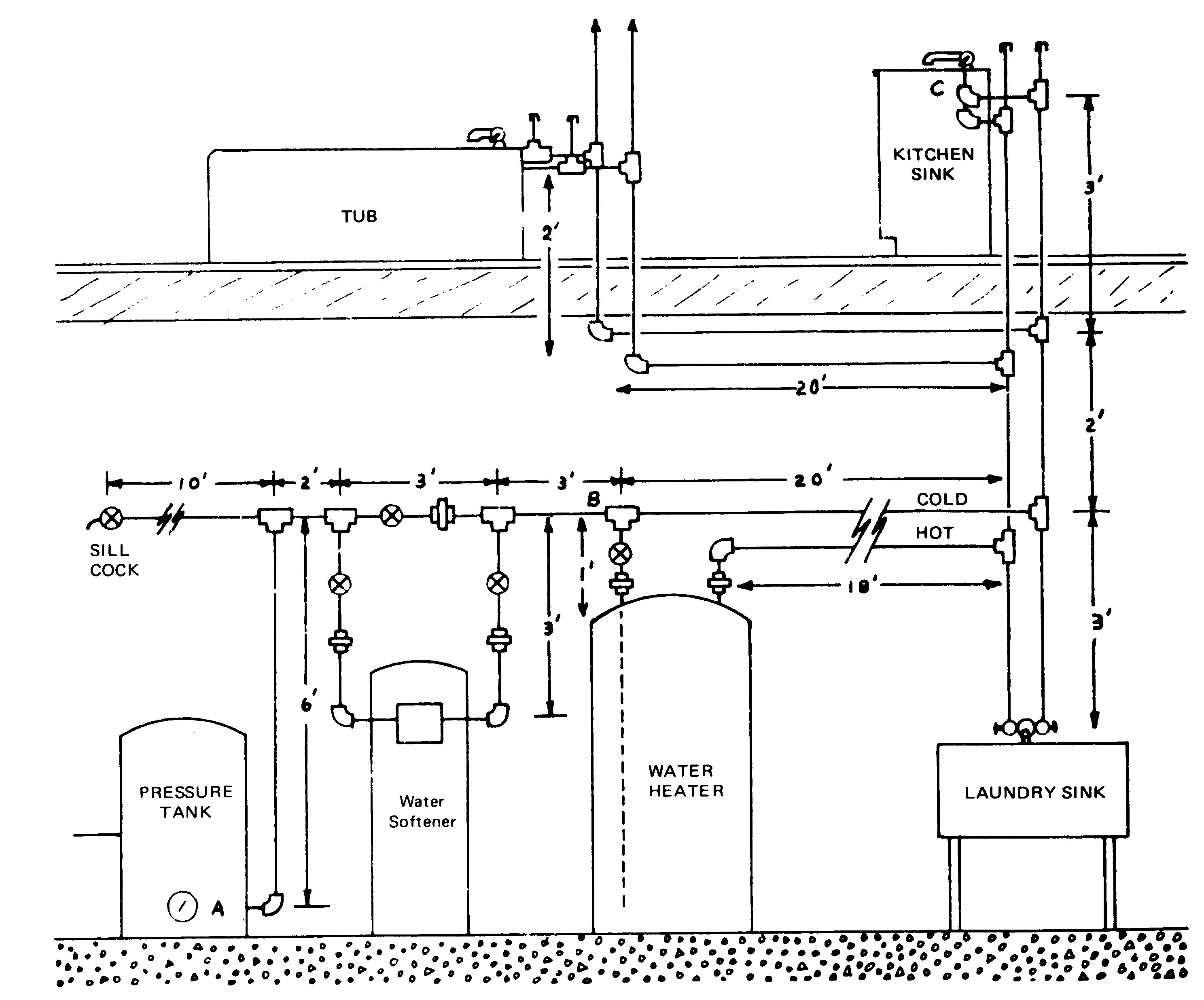
- The TRUTH About America's Water
- Water Pollutants that Cause Illness
- Are Minerals in Water Important for Health?
- Top 5 Drinking Water Contaminants
- Do I Need a Whole House Water Filter?
PRESSURE DROP CONSIDERATIONS II

The pressure drop in a water system varies with the length of pipe, and this must always be measured. In addition, the pressure drop effect of various common pipe fittings can be expressed in terms of equivalent length of pipe. You can find out the values in Table 2 for three sizes of common steel pipe.
Let us assume the following information: the pressure tank operates on a 20-40 psi setting, all pipe is 3/4 inch, the proposed softener has a 6 psi pressure drop at 4.0 gpm, and that a flow of 4 gpm, half hot and half cold water, is desired at the kitchen faucet.
From the drawing and Table 2 the following list can be made:
Points A to B we have 4 gpm flow.
| 1 Tank outlet | X 1.2 ft. | = 1.2 ft. |
| 3 Elbows | X 2.1 ft. | = 6.3 ft. |
| 3 Side outlet tees | X 4.2 ft. | = 12.6 ft. |
| 2 Global valves | X 23.1 ft. | = 46.2 ft. |
| 2 Unions | X 0.44 ft. | = 0.9 ft. |
| Actual feet of pipe | 20.0 ft. | |
| Total | 87.2 ft. |

When 4gpm of water flow thru 3/4-inch pipe has a 3.0-psi pressure drop per 100 feet of pipe. Therefore,
3.0 psi/100 ft. X 87.2 ft. = 2.6 psi 100 ft.
The water must also be lifted to a total of 6 feet from the bottom of the pressure tank to the height of "B." From Table 1, 1 foot of height is equal to .433 psi. Thus,
6 ft. X 0.433 = 2.6 psi
It was stated that the pressure drop through the softener was 6.0 psi at the flow rate of 4 gpm. This must also be added in. Thus,
| Plumbing pressure drop | 2.6psi |
| Net rise pressure loss | 2.6psi |
| Softener pressure drop | 6.0psi |
| Total drop, points A to B | 11.2psi |
The same procedure is used for the pressure drops from points B to C. However, as the flow is now in two paths, each must be calculated separately.
Hot Water-- from Tables 1, Tables 2 and Tables 3:
| 4 Side outlet tees | X 4.2 ft. | = 16.8 ft. |
| 1 Globe valve | X 23.1 ft. | = 23.1 ft. |
| 2 Unions | X 0.44 ft. | = 0.9 ft. |
| 2 Tank entrances | X 1.2 ft. | = 2.4 ft. |
| 2 Elbows | X 2.1 ft. | = 4.2 ft. |
| 25 ft. of pipe | 25.0 ft. | |
| Total | 72.4 ft. |
at 2 gpm, 0.84 psi/100 ft. X 72.4 ft. = 0.61 psi
Net rise, 5 ft. X 0.433 = 2.2 psi
Total: 0.61+2.2=2.8 psi
Cold Water:
| 1 straight thru tee | X 1.4 ft. | = 1.4 ft. |
| 3 Side outlet tees | X 4.2 ft. | = 12.6 ft. |
| 1 Elbow | X 2.1 ft. | = 2.1 ft. |
| 25 ft. of pipe | 25.0 ft. | |
| Total | 41.1 ft. |
at 2 pgm, 0.84/100 ft. X 41.1 ft.=0.35 psi
Net rise, 5 ft. X 0.433= 2.2 psi
Total: 0.35 + 2.2=2.6 psi
In this case, the hot water system has a higher pressure drop than the cold water lines and, therefore, the hot water drop is used in figuring the total pressure drop.
| Points A to B | 11.2 psi | |
| Points B to C-Hot water | 2.8 psi | |
| Total | 14.0 psi | |
As the minimum pressure at the pressure tank is 20 psi, 20.0-14.0 psi or as low as 6.0 psi pressure would be available at the kitchen tap, under the conditions outlined in this problem.
Note: It is an important rule that a minimum of ten pounds of pressure should be available at any tap in order to provide an adequate flow of water. Although it could be argued that the six pounds would be available only when the pressure tank was at its minimum, it is also true that flow could exist at other taps in this home. Therefore, it would be advisable, under these circumstances, to increase the size of the softener to minimize the pressure drop.

